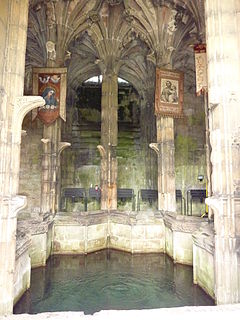Holywell
Holywell
|
|
|---|---|
 St Winefride's Well, Holywell |
|
| Holywell shown within Flintshire | |
| Population | 8,886 (2011 Census) |
| OS grid reference | SJ185755 |
| Principal area | |
| Ceremonial county | |
| Country | Wales |
| Sovereign state | United Kingdom |
| Post town | HOLYWELL |
| Postcode district | CH8 |
| Dialling code | 01352 |
| Police | North Wales |
| Fire | North Wales |
| Ambulance | Welsh |
| EU Parliament | Wales |
| UK Parliament | |
| Welsh Assembly | |
Holywell (Welsh: Treffynnon) is the fifth largest town in Flintshire, Wales. It lies to the west of the estuary of the River Dee.
The market town of Holywell takes its name from the St Winefride's Well, a holy well surrounded by a chapel. The well has been known since at least the Roman period. It has been a site of Christian pilgrimage since about 660, dedicated to Saint Winefride who, according to legend, was beheaded there by Caradog who attempted to attack her. The well is one of the Seven Wonders of Wales and the town bills itself as The Lourdes of Wales. Many pilgrims from all over the world continue to visit Holywell and the Well.
From the 18th century, the town grew around the lead mining and cotton milling industries. The water supply from the mountains above the town, which flows continually and at a constant temperature, supplies the well and powered many factories in the Greenfield Valley. In addition to lead and cotton, copper production was of great importance. Thomas Williams, a lawyer from Anglesey built factories and smelteries for copper in Greenfield Valley, bringing the copper from Anglesey to St. Helens and then to Greenfield Valley where it was used to make many items for the slave trade. These items included manilas (copper bracelets), neptunes (large flat dishes to evaporate seawater to produce salt) and copper sheathing. The copper sheathing was used to cover the hulls of the wooden ships trading in the warmer Caribbean waters, giving rise to the expression 'copper bottomed investment', the sheathing was also applied to Royal Navy ships and was instrumental in Nelson's victories (two of these copper plates from HMS Victory are in Greenfield Valley Heritage Park museum). There was a railway station in Greenfield that was open between 1848 and 1966. Holywell Town station, at the head of a steeply-climbing branch from Holywell Junction, was closed in 1957.
...
Wikipedia

